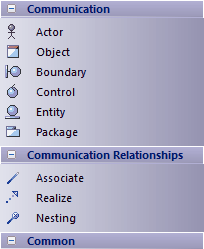Please note : This help page is not for the latest version of Enterprise Architect. The latest help can be found here.
Contents |
| Prev | Next |
Communication Toolbox
The Communication Toolbox is used to develop Communication diagrams, in which you model dynamic interactions between elements at run-time. These diagrams are used to model workflow and sequential passing of messages between elements in real time; they are often placed beneath Use Case elements to further expand on Use Case behavior over time.
The Actor element models a user of the system, while the other elements model things within the system, including standard elements (Object) and the user interface component (Boundary), Controller and Entity.
Communication Toolbox pages
Image |
Detail |
See also |
|---|---|---|

|
Except where discussed here, each element and relationship that you can create using these Toolbox pages is described in the UML Elements and UML Connectors sections of the Help. A Boundary is a stereotyped Object that models some system boundary, typically a user interface screen. A Control is a stereotyped Object that models a controlling entity or manager. An Entity is a stereotyped Object that models a store or persistence mechanism that captures the information or knowledge in a system. |
Behavioral Diagram Elements Control Boundary Structural Diagram Elements Entity UML Connectors |
Notes
Learn more
